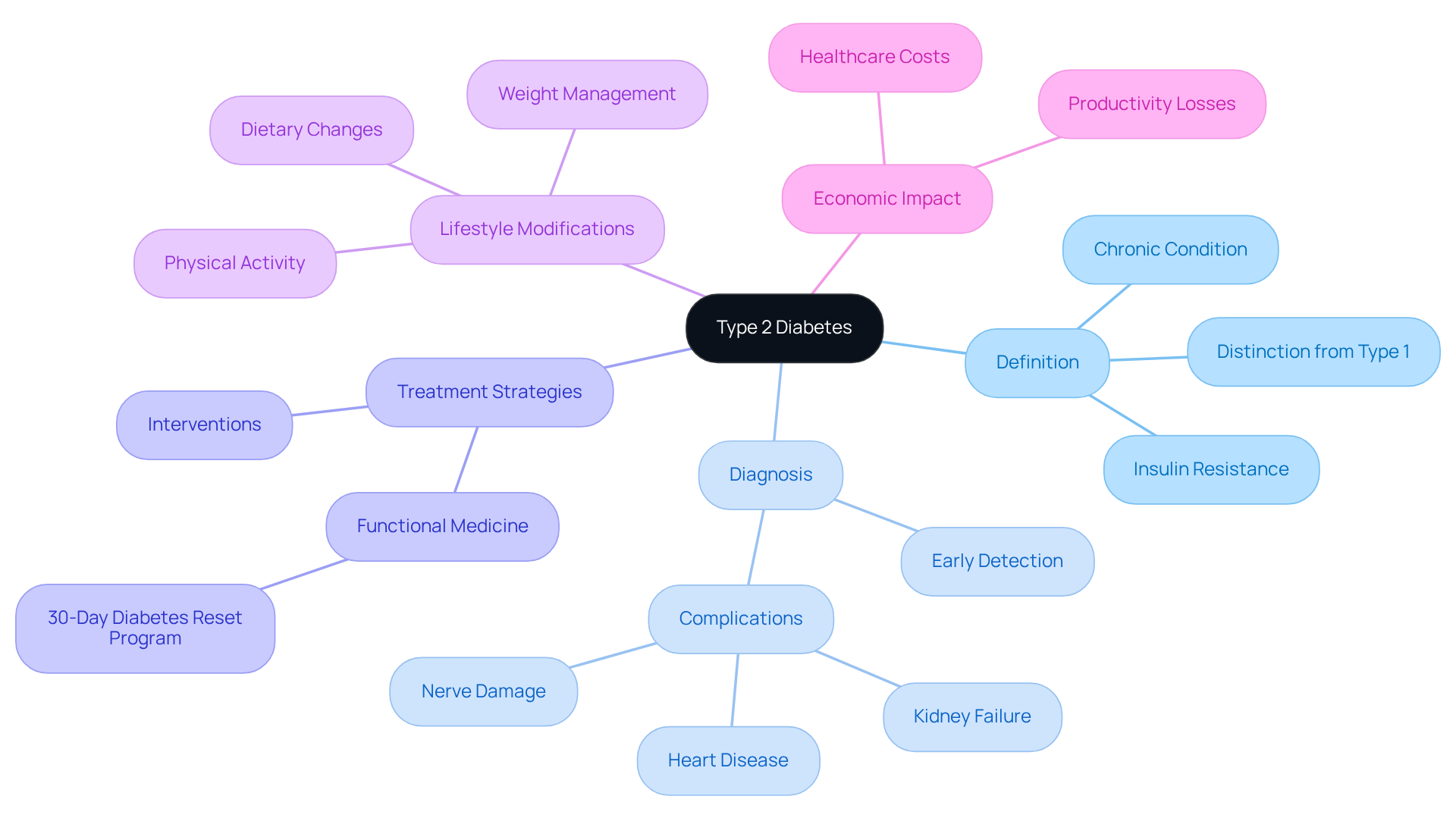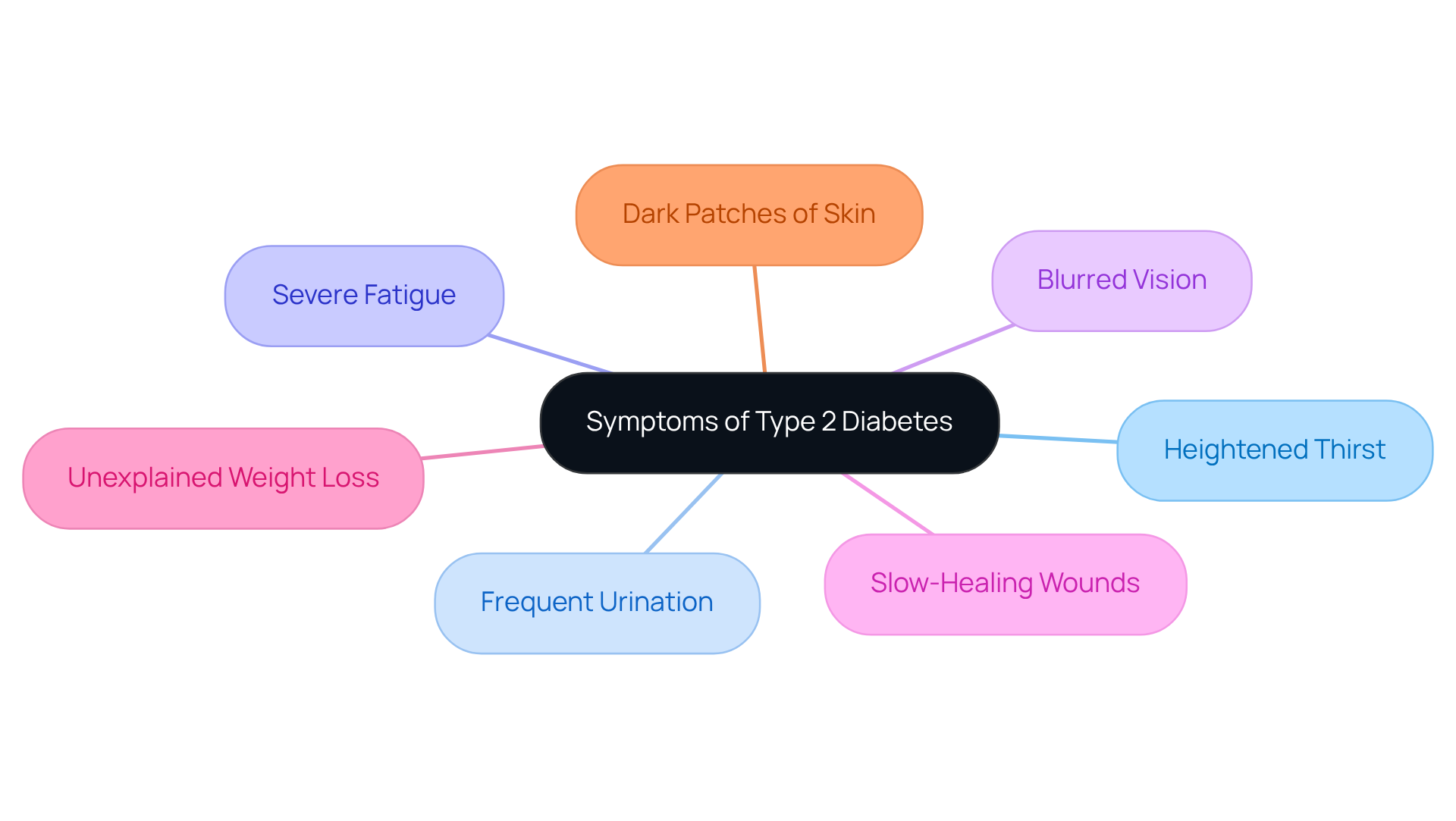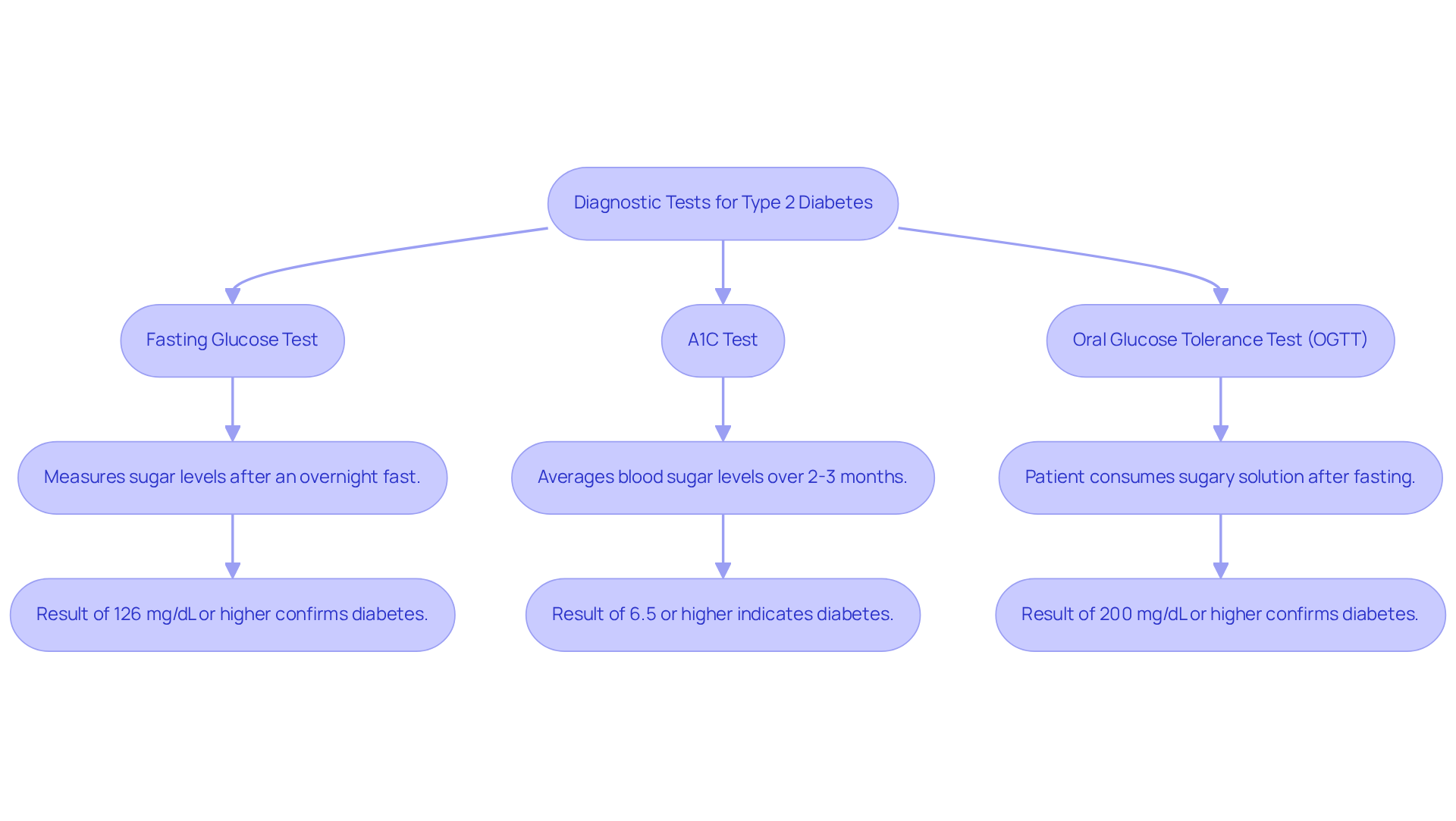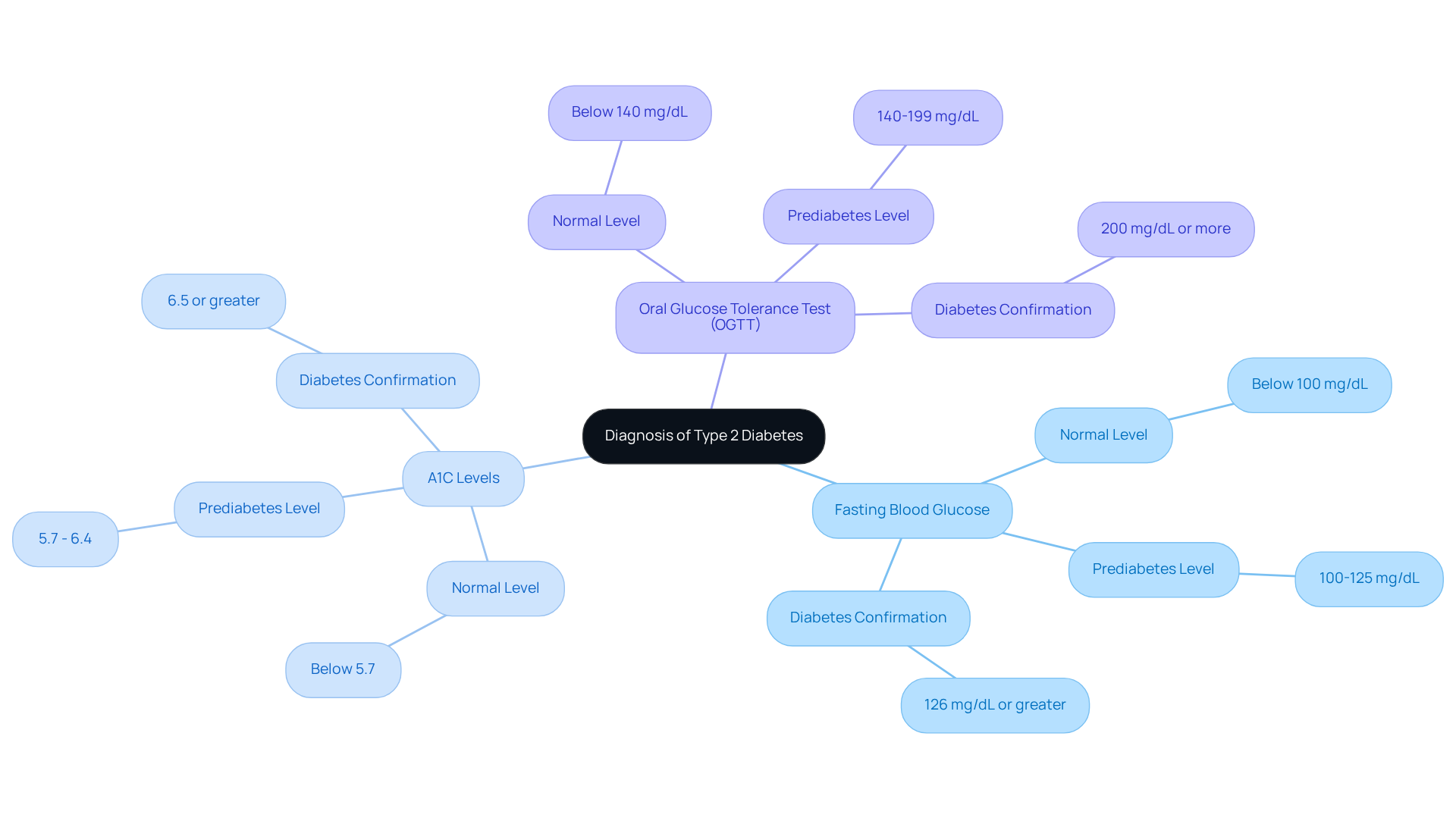Overview
Diagnosing Type 2 diabetes can feel overwhelming, but healthcare professionals are here to guide you through the process. They typically start by recognizing symptoms and then proceed with specific blood tests, such as:
- The fasting glucose test
- A1C test
- Oral glucose tolerance test
It’s important to understand that interpreting these results is crucial for confirming the diagnosis.
Many patients find that early detection is key to managing their health effectively. The article highlights how timely diagnosis can help prevent serious health complications and improve overall well-being. Embracing lifestyle modifications can be a powerful step in this journey, supported by various studies and expert recommendations. Remember, you are not alone in this; there are resources available to help you take charge of your health.
Introduction
Type 2 diabetes is a widespread health challenge that affects millions, often remaining undiagnosed until serious complications emerge. It’s important to recognize that understanding how to diagnose this condition is not just a medical necessity; it’s a vital step towards regaining control over one’s health and preventing long-term repercussions. As awareness grows, so does the urgency to address the symptoms and diagnostic criteria that can lead to timely intervention. Many patients find that navigating the complexities of diagnosis can be daunting, but taking proactive steps towards effective management is within reach.
How can you begin this journey toward better health?
Understand Type 2 Diabetes: Definition and Importance
Type 2 diabetes mellitus is a chronic condition that many face, characterized by the body’s struggle to effectively use insulin, leading to elevated blood sugar levels. Unlike Type 1, where insulin production is absent, Type 2 involves insulin resistance or inadequate insulin production. This distinction is crucial as it shapes treatment strategies and necessary lifestyle modifications. It’s important to recognize how do you diagnose type 2 diabetes early, as prompt detection can prevent serious complications such as heart disease, kidney failure, and nerve damage.
Many patients find that early intervention can significantly enhance their wellness results. Research shows that lifestyle modifications can lower the likelihood of developing health issues by as much as 58%. Furthermore, successful interventions through functional medicine, such as Dr. Shumard’s 30-Day Diabetes Reset program, empower patients with the knowledge and tools to manage their condition effectively. As Dr. Jason Shumard states, “I concentrate on reversing the second type of diabetes and addressing hypothyroidism through functional medicine,” emphasizing the center’s dedication to holistic care.
Grasping the condition of Type 2 diabetes and understanding how do you diagnose type 2 diabetes can lead to an improved quality of life and a proactive strategy for wellness management. Additionally, the total estimated expense of diagnosed diabetes-related issues in the U.S. in 2022 was $412.9 billion, underscoring the economic impact of this condition. By promoting awareness and knowledge, patients can take charge of their well-being and lessen the impact of this condition. Remember, you are not alone in this journey; support and resources are available to help you thrive.
Identify Symptoms of Type 2 Diabetes
If you’re experiencing signs of glucose intolerance, such as heightened thirst, frequent urination, severe fatigue, blurred vision, or slow-healing wounds, know that you’re not alone. These symptoms can be concerning, and it’s important to recognize that they may indicate a need for further evaluation. Some individuals also notice unexplained weight loss or dark patches of skin, especially in areas like the armpits and neck.
If you notice any of these symptoms, it’s crucial to consult a healthcare professional to learn how do you diagnose type 2 diabetes. Understanding what you’re going through can empower you to take proactive steps toward diagnosis and management. Remember, seeking help is a sign of strength, and there are resources available to support you on your journey to better health.
Conduct Diagnostic Tests for Type 2 Diabetes
Identifying type 2 conditions can feel overwhelming, but understanding how do you diagnose type 2 diabetes can provide vital information regarding sugar levels and overall well-being. The primary tests include:
-
Fasting Glucose Test: This test measures sugar levels after an overnight fast. A result of 126 mg/dL or higher confirms the presence of the disease. It’s important to recognize that this test reflects how well your body manages glucose without recent food intake.
-
A1C Test: This blood test averages blood sugar levels over the past two to three months. An A1C of 6.5% or higher indicates the presence of high blood sugar. Many patients find that lowering the A1C threshold to 6.03% could improve early identification of the condition in previously undiagnosed individuals. This test is especially important as it aids in evaluating long-term glucose regulation, which is crucial for effectively managing your health.
-
Oral Glucose Tolerance Test (OGTT): After fasting, patients consume a sugary solution, and blood sugar levels are tested at intervals. A reading of 200 mg/dL or higher two hours after ingestion verifies the condition. This test is particularly useful for identifying insulin resistance and assessing how your body processes glucose.
Comprehending these tests is crucial for effective management of blood sugar levels, especially when discussing how do you diagnose type 2 diabetes. For instance, losing merely 7% of body weight can enhance sugar regulation for individuals with prediabetes or type 2 conditions. Additionally, it’s noteworthy that the prevalence of diagnosed diabetes has been shown to increase with age, with rates of 11.3% diagnosed and 4.5% undiagnosed during August 2021-August 2023. This highlights the importance of regular screenings, especially for those over 35, who should have initial blood sugar screenings, with follow-ups every three years if results are normal.
Consulting with a medical professional is essential to identify the most suitable test based on your personal wellness profile and risk factors. This proactive approach not only aids in accurate diagnosis but also empowers you to take control of your health journey.
Interpret Test Results and Understand Your Diagnosis
Interpreting your test results is a crucial step in understanding how do you diagnose type 2 diabetes. It’s important to recognize that these results can be overwhelming, but they provide valuable insights into your health. Here’s a breakdown of the key tests:
- Fasting Blood Glucose: A normal level is below 100 mg/dL. Levels between 100-125 mg/dL suggest prediabetes, while a measurement of 126 mg/dL or greater confirms the condition. Prediabetes fasting blood glucose ranges from 100 mg/dL to 125 mg/dL.
- A1C Levels: An A1C below 5.7% is considered normal. If your A1C is between 5.7% and 6.4%, it indicates prediabetes, and an A1C of 6.5% or above verifies the condition. Diabetes is diagnosed at an A1C of greater than or equal to 6.5%.
- Oral Glucose Tolerance Test (OGTT): A normal reading is below 140 mg/dL. Values ranging from 140-199 mg/dL suggest prediabetes, while a measurement of 200 mg/dL or more verifies the condition.
Understanding how do you diagnose type 2 diabetes is essential for effective management. Many patients find that once they grasp how their A1C levels connect to their overall well-being, they feel empowered. Dr. Jason Shumard highlights, “Participating in dialogues with healthcare professionals regarding these results can result in customized management strategies that cater to personal requirements, ultimately enhancing wellness outcomes.”
Moreover, it’s important to recognize that including consistent exercise, like moderate activity for 30 minutes daily, five days a week, can greatly assist in lowering the risk of developing this condition. Engaging in discussions with healthcare providers about these results can lead to tailored management strategies that suit individual needs, ultimately improving health outcomes. Remember, you are not alone on this journey; support is available to help you thrive.
Implement Lifestyle Changes and Follow-Up Care
After understanding how do you diagnose type 2 diabetes, it’s important to recognize that making lifestyle adjustments is essential for effective management. Here are some essential steps to consider:
-
Nutrition: Prioritize a balanced diet that emphasizes whole foods, including a variety of vegetables, lean proteins, and healthy fats. Research indicates that dietary patterns rich in fiber and low in processed sugars can significantly lower blood glucose levels. For example, many patients find that adopting a Mediterranean diet, rich in fruits, vegetables, and whole grains, has been associated with a nearly 60% lower risk of developing type 2 sugar intolerance. Furthermore, targeting a weight reduction of 5% – 7% can further decrease the risk of blood sugar issues, making dietary changes even more significant.
-
Physical Activity: Aim for at least 150 minutes of moderate exercise each week. Engaging in activities such as brisk walking, swimming, or cycling not only helps in weight management but also improves insulin sensitivity. Research shows that consistent physical exercise can decrease the likelihood of complications associated with high blood sugar by roughly 50%. It’s crucial to note that being physically inactive increases the risk of developing type 2 diabetes, so incorporating movement into your daily routine is essential.
Monitoring is essential when considering how do you diagnose type 2 diabetes, which includes regularly checking your glucose levels as advised by your healthcare provider. Understanding how your body responds to different foods and activities is vital for effective management, particularly in relation to how do you diagnose type 2 diabetes. Keeping a food and exercise diary can help identify patterns and make necessary adjustments. Consistent meal timing and steering clear of snacks can also aid in improved sugar regulation.
- Follow-Up Care: Schedule regular check-ups with your healthcare provider to monitor your condition and adjust your management plan as needed. Consistent follow-up is essential for managing blood pressure and cholesterol levels, which are critical for overall health. Participating in educational materials, like seminars and books provided by Dr. Shumard’s center, can equip you with knowledge and tools to manage your condition effectively.
By taking these proactive steps, you can effectively manage your diabetes and enhance your overall well-being. Empowering yourself with knowledge about nutrition and exercise can lead to significant improvements in your health outcomes.
Conclusion
Understanding how to diagnose type 2 diabetes is crucial for effective management and prevention of serious health complications. Early detection allows individuals to take proactive steps that can significantly improve their quality of life. It’s important to recognize that by acknowledging the signs and symptoms, conducting necessary diagnostic tests, and interpreting results accurately, individuals can empower themselves to navigate their health journey with confidence.
Many patients find that recognizing symptoms such as increased thirst and fatigue is the first step toward diagnosis. The article highlights key aspects of diagnosing type 2 diabetes, including various diagnostic tests like the fasting glucose test and A1C test, and the significance of interpreting these results. Additionally, it emphasizes the necessity of lifestyle changes, such as adopting a balanced diet and engaging in regular physical activity, to manage the condition effectively. Follow-up care and continuous monitoring are also critical components that help maintain optimal health outcomes.
Ultimately, the journey toward managing type 2 diabetes begins with awareness and education. By taking the initiative to understand the diagnostic process and implement lifestyle changes, individuals can significantly reduce their risk of complications and enhance their overall well-being. It is essential to consult healthcare professionals regularly and stay informed about the latest recommendations and strategies to thrive while living with diabetes. Remember, you are not alone in this journey; support is always available to guide you toward a healthier future.
Frequently Asked Questions
What is Type 2 diabetes?
Type 2 diabetes mellitus is a chronic condition where the body struggles to effectively use insulin, resulting in elevated blood sugar levels. It differs from Type 1 diabetes, which involves complete absence of insulin production, as Type 2 is characterized by insulin resistance or inadequate insulin production.
Why is early diagnosis of Type 2 diabetes important?
Early diagnosis is crucial because it can prevent serious complications such as heart disease, kidney failure, and nerve damage. Prompt detection allows for timely interventions that can significantly enhance wellness outcomes.
What lifestyle modifications can help manage Type 2 diabetes?
Research indicates that lifestyle modifications can reduce the likelihood of developing health issues related to Type 2 diabetes by as much as 58%. These modifications may include dietary changes, increased physical activity, and weight management.
What is Dr. Shumard’s 30-Day Diabetes Reset program?
Dr. Shumard’s 30-Day Diabetes Reset program is a functional medicine intervention designed to empower patients with the knowledge and tools needed to manage their Type 2 diabetes effectively.
What are common symptoms of Type 2 diabetes?
Common symptoms include heightened thirst, frequent urination, severe fatigue, blurred vision, slow-healing wounds, unexplained weight loss, and dark patches of skin, particularly in areas like the armpits and neck.
What should I do if I experience symptoms of Type 2 diabetes?
If you notice symptoms of glucose intolerance, it is important to consult a healthcare professional for further evaluation and to understand how to diagnose Type 2 diabetes.
What is the economic impact of Type 2 diabetes in the U.S.?
The total estimated expense of diagnosed diabetes-related issues in the U.S. in 2022 was $412.9 billion, highlighting the significant economic burden of this condition.
How can patients take charge of their well-being regarding Type 2 diabetes?
By promoting awareness and knowledge about Type 2 diabetes, patients can take proactive steps in managing their condition, utilizing available resources and support to improve their quality of life.




